 Pirates and Privateers Pirates and Privateers
The History of Maritime
Piracy
Cindy Vallar, Editor
& Reviewer
P.O. Box 425,
Keller, TX 76244-0425
    
Books for Adults ~ Alternative
Fiction & Time Travel
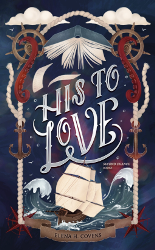
His to Love
by Elena H. Covens
Black Library, 2024, ebook ASIN B0D6Z8JD83, US $5.00 /
CAN $6.92
Also available in other formats
A decade
has passed since Emily Underwood’s father’s ship
vanished. Now, if she and her mother want to keep
their house, Emily must marry. She’s not keen on
the idea; after all, the lord’s twice her age and
eccentric. She likes her independence. She also
craves adventure. Rather than face the issue,
Emily goes to her special place, the local
library, even though a storm brews. Upon arriving,
she takes her favorite book, The Adventures of
the Cross Bone Pirate Thief, and begins to
read about Flynn Sawyer and his daring plan to
topple the evil king. She already knows what will
happen; she’s read this book multiple times.
Except this time, a lightning bolt strikes and
she’s no longer in 1852 London. She now resides
within the pages of the book, which takes place
over a century earlier.
Flynn Sawyer
assumes the girl he stumbles upon in the dark is a
princess and takes her in tow. After all, she can
be used against her father to gain what Flynn
wants. He scoffs at her claims that she’s not who
he thinks she is. After all, he’s the most feared
pirate in the kingdom and he never makes mistakes
or commits acts of stupidity. Still, there’s
something off about this princess who claims to be
a psychic because she knows so much about him and
what he wants. Another problem is that he’s
attracted to her; she is so different from the
others who have crossed his path. Not a good thing
when he’s determined to exact revenge against the
king for killing his father.
His To Love
is a delightful adventure where sometimes getting
what you wish for comes with its own problems and
consequences. What further complicates this time
travel is that instead of traveling into the past
or future, Emily travels to a fictional world and
her intrusion may forever change the story that
means so much to her. The real conundrum: How can
she love someone who’s not real?
At times, the
narrator steps in to remind readers of what he/she
promises at the start of the story. These are not
intrusive, but your interpretation may not be the
narrator’s interpretation. Love scenes are
explicit. There are expected twists, but they may
not be the ones you think. Despite the occasional
copyediting and formatting issues, this is a good
and different time-travel romance. You may find
yourself falling into the pages of the pirate tale
much like Emily does. To further seal the deal,
Covens also entices readers with a teaser for the
next title in the series, His to Heal.
Review Copyright ©2024 Cindy Vallar


1636: Commander Cantrell in the West Indies
By Eric Flint & Charles E. Gannon
Baen, 2014, ISBN 978-1-4767-3678-5, $25.00
Also available in e-book formats
What
if the citizens of a small, West Virginia town
find themselves transported from the 20th century
to 17th-century Europe during the Thirty Years
War? That’s the premise of the novels known
collectively as The Ring of Fire or 1632 series. 1636:
Commander Cantrell in the West Indies is the
latest installment in this alternative history.
Lt. Commander Eddie
Cantrell is an up-and-coming officer in the United
States of Europe’s navy. The USE and Denmark have
become allies, and his skill as a gamer, his
military history studies, and his being a
technology geek provide him with the expertise he
needs to wend his way through a serpentine web of
court intrigue, royal protocols, and naval orders.
This time around, he journeys to the New World,
where Spain claims ownership of all lands and the
treasure they contain. The allies seek to upend
this monopoly, but their target isn’t gold or
silver. Rather Eddie is tasked with insuring they
have access to a more precious commodity – oil.
Eddie’s fleet
consists of steam-powered frigates and old world
sailing ships, which provide a vast array of
modern and old technologies to carry out his
orders. But to succeed in this mission, he needs a
diversion – one that his boyhood friend, Mike
McCarthy, Jr., must implement. And it requires the
assistance of Irish mercenaries allied with Spain.
The plans may go awry in any number of ways, what
with hostile natives, pirates, starving colonists,
and enemies who plot to thwart the USE’s plans.
Having an amorous wife along merely adds further
complications Eddie can’t afford as the various
factions slowly come together in a showdown that
requires thinking outside the box for Eddie and
his comrades to be victorious.
Having read and
enjoyed another of Eric Flint’s alternative
histories, I wanted to read this one even though I
haven’t read any of the previous titles in the
series. He and Gannon write an intriguing tale
filled with what-ifs that never strain the
reader’s ability to believe this might occur.
Although unfamiliar with the backstory and
characters, I had no trouble following the various
story threads, and the book begins with a short
overview to set the stage. The authors also
include a cast of characters at the end of the
novel, as well as maps of the Spanish Main and
Leeward Islands and a glossary of terms to further
orient the reader. This is a great story, albeit a
long one at 613 pages. It shines an entirely new
spotlight on what might have happened had
Europeans had access to future technologies while
attempting to colonize islands and territories
that Spain laid claim to in the New World. The
pirates are true buccaneers except for one detail
– which makes this a true alternative history.
They aren’t major players in the overall scheme of
this narrative, but they add an interesting angle
that rings true.
Meet the authors Flint and Gannon
Review Copyright ©2014 Cindy Vallar

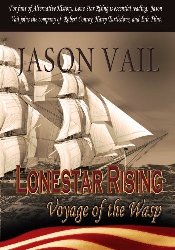
Lone Star Rising: Voyage of the
Wasp
By Jason Vail
Fireship Press, 2012, ISBN 978-1-61179-235-5, US
$16.00 / CAN $19.95
In October 1776, American rebels
encounter the British army at Harlem Heights.
One casualty is General George Washington and,
soon after, the rebellion is put down.
Tennesseans, however, live on the frontier
away from the British and, in 1804, they
declare themselves a free state. The British
don’t respond until four years later; although
they gain the upper hand, the remnants of that
rebel force move to the Spanish territory of
Texas under the leadership of Andrew Jackson.
The community of Jacksonville thrives, but the
influx of non-Catholics who refuse to heed
Spanish laws eventually alarms the Mexican
authorities. Andrew Jackson, though, has no
intention of surrendering his freedom or
power.
After
a near-fatal run-in with a Spanish frigate in
April 1819 and a double-dealing employer, John
Paul Jones II leaves New Orleans and returns
home to Baltimore, only to find that his
family is dead. Seven months later, an
unemployed and cynical Jones is approached by
Davy Crockett, who holds a letter of
introduction from Jones’s former employer.
Crockett hires Jones to find a suitable ship
that can be outfitted – illegally and
surreptitiously – as a naval warship. Crockett
is dubious that the ramshackle vessel will
ever amount to anything, but Jones proves him
wrong. Hired to sail Crockett and the Wasp
to New Orleans, Jones soon finds himself
part of the Texas Navy and allied with French
pirates. But the captain of a Spanish frigate
knows of the rebel vessel and is hunting for
the elusive Wasp and her captain.
This
alternative history novel, the first in a
series, presents an interesting series of
what-ifs about the early days of Texas
history. Told mostly from Jones’s point of
view, the tale is interlaced with excerpts
from A Short History of the Republic of
Texas and the Free States of America
by Victor D. Lautenberg. The problem is that
Vail tends to lead the reader to an exciting
point in the story, then steps back to let
Lautenberg tell what happens. As a result, the
action fails to rivet the reader’s attention.
Even so, Lone Star Rising makes
readers wonder about what would have happened
had the United States never been, while
pirates from Jean Laffite’s Barataria
operations assist the fledgling nation of
Texas in gaining its freedom.
Review
Copyright ©2013 Cindy Vallar

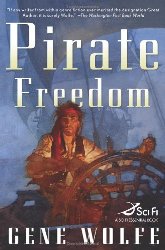 Pirate Freedom
Pirate Freedom
By Gene Wolfe
Tor, 2007, ISBN 978-0-7653-5850-9, US $9.99 /
CAN $13.99
reviewed by Laura Nelson
Chris,
Christopher, or Crisoforo lives in a
monastery in Cuba, initially to attend the
boarding school there. When the school
closes, he stays on a couple more years, but
decides he isn’t interested in studying to
be a priest, and leaves, wearing only the
now three-sizes-too-small tee shirt and
jeans he wore when he arrived.
At first, he
fails to notice that everything is different
from what he remembers. Then he is unable to
find his father’s house. There aren’t any
cars or roads or landmarks he’s familiar
with either. But he doesn’t have time to
dwell on this, as he is caught in a daily
struggle to survive. Eventually, an
opportunity to work on a wooden sailing ship
comes along and he takes it, entranced with
the idea of regular meals and a place to
sleep. But few things are ever as simple as
they sound, and he is not warmly greeted by
the other sailors.
He starts to
learn the job, but the journey is
interrupted when the ship is captured by
pirates. Chris refuses to sign their
articles and thus becomes their prisoner.
Rather
improbably, the captain of the pirates, Bram
Bart, takes a liking to him, and after they
capture another vessel and decide to make it
into a consort, Bart offers the command to
Chris. Thus the real adventures of the book
begin.
The captured boat
is a slaver. Chris sells the slaves and
keeps the money to buy another vessel, but
ends up getting robbed. He has to join the
buccaneers on Tortuga to make some money.
Then he, Melind
(a man he befriends while living as a
buccaneer), and a few others capture a ship
in the night and take it over. The boat
includes some Spanish prisoners, two or four
men and a boy, who asks to speak to Chris in
private. When they’re alone, the boy reveals
that he is Estrellita, a maid whom he wooed
on Coruna. She donned men’s clothing and ran
away from the high class Spanish family that
employed her.
Chris calls her
“Novia,” which means sweetheart, and she
becomes as fierce as any of the male
pirates. She also plays a central role in
running the ship. Toward the end of the
story comes a bit of sexual intrigue when
Chris finds out Estrellita’s true identity
and that she is pregnant. But that’s as
“steamy” as the book gets. (Sorry guys!) To
tell you the reason she hides her true
identity from Chris would ruin the end of
the book, so you’ll have to read that part
for yourself!
Pirate Chris’s
story is interwoven with that of modern-day
Chris, a Catholic priest. We are never told
an exact year either lives in, although we
are given some hints. Pirate Chris talks
about how long it took him to learn to load
a musket and utilizes some of his modern-day
knowledge to make a few alterations and
improvements to the ship to assist the
pirates in capturing prizes. Father Chris
reminisces about his father teaching him to
shoot a laser pistol. He also comments on
reading modern stories of pirates and about
Anne Bonny and Mary Read. He believes that
Novia was probably just as fierce, if not
more so, than they were.
The story is set
in the age of wooden sail, and Wolfe seems
to have done his homework about the period
fairly well. One thing I like is that he
never employs the over-used plot device of
placing the main character amongst the crew
of, say Blackbeard, and then re-telling a
familiar story from this character’s “unique
perspective.” Nor does he invent an
alternate timeline for Blackbeard, allowing
him to live longer or only appear to have
been killed.
Chris faces many
moral challenges, both as a priest and as a
pirate. Because of his childhood upbringing
in a monastery school, he often agonizes
over some of the choices he faces in order
to survive. He experiences guilt over the
plight of some of his victims. As the story
draws to its conclusion, his biggest moral
choice becomes whether to travel back in
time to warn himself about leaving the
monastery and being sent back in time, or to
rejoin his lover from his pirate days.
Some readers may
not care for the way Wolfe brings in moral
lessons and religious beliefs into some of
Chris’s decisions. Personally, I found the
contrasts and his inner struggle about what
is right and wrong to be insightful and
interesting.
There is a moment
of levity provided when Chris sees that the
ship they have just captured is called Castillo
Blanco (White Castle), but it
doesn’t have any hamburgers.
As part of their
adventures, they soon learn from the
captured crew that Castillo Blanco is
a cursed ship. Several sailors have
disappeared or turned up dead.
Toward the book’s
end, the pirates set out on a Henry
Morgan-style land invasion of Portobello
with the ultimate goal of robbing one of the
Spanish mule trains carrying loads of gold.
Some of the obstacles they encounter
resemble the hardships Morgan and his men
endured during their land campaigns, but
this is the only part of the book that feels
as if some of it may have been taken from a
real pirate story.
The only other
detraction from the book I find is that it
is highly narrative, sometimes neglecting to
drop the reader into the action, keeping the
reader at arm’s length. A character will say
something, but instead of just replying, the
author interrupts by having Chris say, “And
I told him . . . .” The story could have
been a lot more action-packed at times.
Pirate Freedom
has very nice illustrations at the beginning
of each chapter, which adds a nice touch to
the story. The paperback I bought is 417
pages and has a glossary at the end to help
with a few terms and locations. Overall, I
rate this book at four stars, only because
of the large amount of narration throughout
the story. It’s still a good read and
something a bit different from many recent
pirate stories.
Meet the author
Review Copyright ©2018 Laura
Nelson

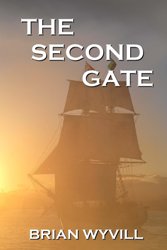
The Second Gate
By Brian Wyvill
Thunderchild, 2018, ISBN 978-1719243773,
US $12.99 / CAN $17.25
e-book US $2.99 / CAN $3.83
Crossing
a secluded area at the University of
Victoria in British Columbia, Sarah
Malette notices a man following her. He
is the spitting image from a childhood
nightmare. The experience rattles her,
but she chalks it up to his being
homeless and hurries on her way. Instead
of finding Professor Duncan in his
office, she encounters his teaching
assistant. (Annette is like a sister,
since she and Sarah grew up together
after Annette’s mother disappeared.)
Together they marvel at the nautical
artifacts decorating Duncan’s office.
They all date from the late eighteenth
century, which makes sense because of
his fascination with the Napoleonic
wars; what is odd is that they look
brand new, even though it’s 2015. They
also discover a door, hidden behind a
coat rack, leading to an empty room.
Annette, who
is French Canadian, also has a keen
interest in the same time period. Her
focus and thesis are on the year 1798,
particularly on a single event: the
Battle of the Nile. She believes that
had Admiral Brueys won the engagement,
rather than Admiral Nelson, all of
Canada might be French, rather than just
Quebec. When Sarah mentions the homeless
man, Annette is also troubled. Could
this be the same man who terrorized her
and her mother when she was younger? Is
he looking for her?
Ken DiPalo, a
friend and fellow classmate of Sarah’s,
is infatuated with Annette, who thinks
he’s more of a class clown, who’s always
shirking his schoolwork. To demonstrate
otherwise, he shares charts and maps
stored on his smart phone with Annette
and Sarah, who are also working on the
same 1798 project. He also mentions that
one 1720 resource discusses a man named
Masthead Duncan – the same name as their
professor. Sarah reveals that she came
across a Royal Navy lieutenant with the
same name in 1757. Another source places
Duncan in 1798 on Malta. The unusual
first name puzzles them because they
can’t possibly be the same man given the
activities mentioned and the ages of
each man. It’s a coincidence they might
query their professor about, but no one
has seen or heard from him since he
turned up at a local hospital with a
knife wound.
Further
discussion reveals several other
oddities, one of which involves the
hidden room in Duncan’s office. Ken
comes up with a theory based on the
evidence, which seems almost impossible
to believe – time travel. The answer may
be in the professor’s office and Ken
just happens to have a key. Sarah is
reluctant to break into the office, but
Annette believes this may be her only
chance to find her mother and perhaps
provide Admiral Brueys with the
necessary information to change the
outcome of the battle. After acquiring
the key and Ken’s smart phone containing
the maps, she eludes the others to
locate the gateway that will take her to
1798 Malta. Having a duplicate key, Ken
and Sarah attempt to stop her, but she’s
vanished by the time they get to the
office. The only thing they can do is
follow her through the gateway to find
Masthead Duncan and stop Annette from
changing history.
Going back in
time may sound like fun, but it’s
fraught with danger. Aside from
stability issues with the gateway, their
adventures include encounters with
Barbary pirates, mutineers, kidnappers,
galley slaves, and a sheik seeking a new
bride. Rock climbing, safeguarding
treasure, trekking across the desert,
and participating in sea battles add
further excitement to entice and engage
readers. The love scene between two of
the characters lacks the smooth flow
present throughout the rest of the
story. A few spots may puzzle readers –
the delay between the time the French
officers find the phone and confront
Annette, for example – but Wyvill crafts
a believable and compelling time travel
that provides startling answers to the
questions of what if France had won the
battle at Aboukir Bay and how does a
single misstep in the past affect the
future. The Second Gate is the
first book in a new series and promises
some intriguing future adventures for
the characters we meet in this volume.
Meet
the author
Review Copyright ©2019
Cindy Vallar

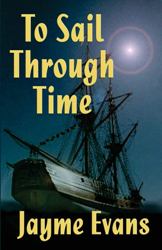
By Jayme Evans
Wings Press, 2002, ISBN 1-59088-075-7
(e-book), $6
ISBN 1-59088-959-2 (paperback), $11.95
An
eerie Caribbean storm threatens to
ruin Dr. Bethany Henry's
well-deserved vacation with her twin
brother. She tosses aside the pirate
romance she's reading to help Bryce
secure everything before a
waterspout engulfs them. After the
terrifying funnel passes, they
encounter a wooden sailing ship
manned by authentic-looking pirates
captained by a handsome swashbuckler
named Joshua Blackmon.
Although
Joshua understands little of what
Bethany says, he realizes she and
her brother are from the future.
Bryce's T-shirt says 1999, but the
year is 1814, and Joshua and his
crew are privateers. A superstitious
lot, his men will think Bethany a
sorceress if he doesn't protect her.
To that end he locks her in his
cabin and imprisons Bryce in the
brig until he can convince them that
he and his men aren't reenactors and
that the twins have traveled back in
time.
Bethany
is an independent woman who rails at
captivity, but she fears the
captain's crew more and won't
jeopardize her brother's life. She
scoffs at Joshua's hypothesis, until
he forces her to watch a bloody sea
battle unfold. If Joshua dies, what
will become of her and Bryce? Will
they ever return to their own time?
If not, how will she adapt to living
in a time when women lacked the
independence and freedom of her
century?
This
fast-paced story portrays pirates
with realism often lacking in
historical romance. Discovering a
tie-in with Jean Laffite was an
added treat and, while Bethany
shares her knowledge of what will
happen to the Baratarians, Ms. Evans
neatly weaves the facts into the
story without allowing Bethany's
knowledge to alter history.
Adventure, mutiny, danger, and love
combine to make this an intriguing
what-if tale of pirates and
privateers.
Review
Copyright ©2002 Cindy Vallar

Click to contact me
Background image compliments
of Anke's Graphics |






